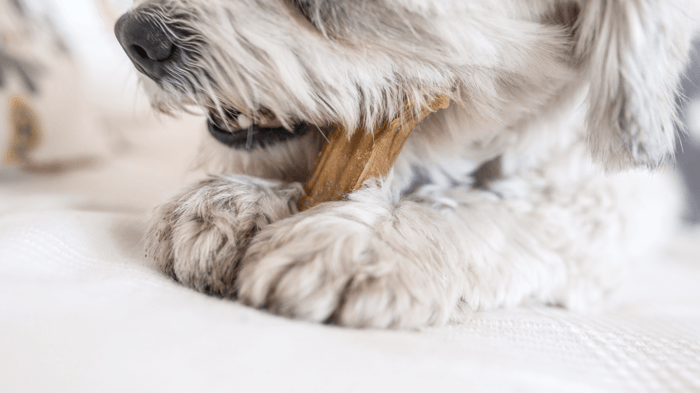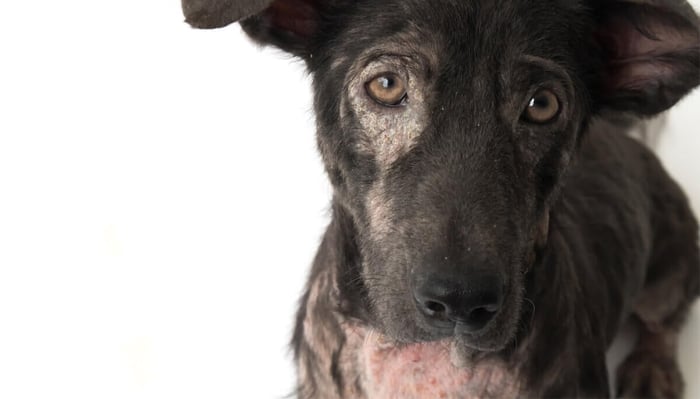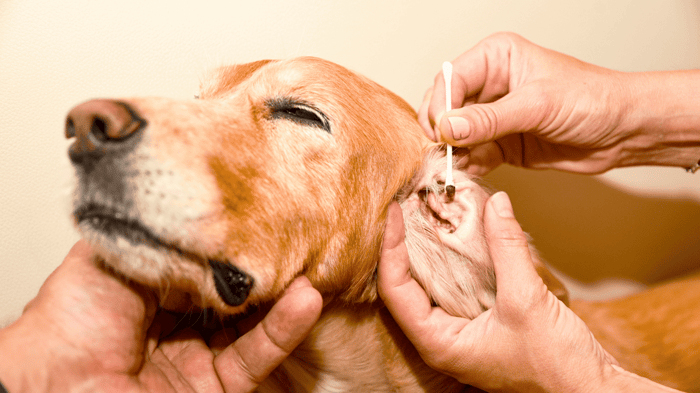When a dog undergoes surgery, it is common for them to receive stitches to close the incision site. However, sometimes, these stitches can open up without any bleeding. This can cause concern for pet owners who may wonder if their dog’s wound is healing correctly.
Hiccups in canine surgery post-care happen all the time. You may encounter them even when you do everything right, like providing a proper resting area, sticking to medications, and minimizing your dog’s activity.
Luckily, dog stitches come undone all the time, so it’s nothing to panic about too much. Still, take action and give your vet a call for direction. We’ve looked at expert sources like the Standards for Wound Management and Jolle Kirpensteijn’s Post-surgery Guide for professional advice on open dog stitches.
So, Why Are My Dog’s Stitches Open But Not Bleeding?
One possible explanation is that the dog may have been too active or licked the area excessively, causing the stitches to loosen or break. Another possibility is that the stitches were improperly placed or not strong enough to hold the wound closed. Sometimes, the dog’s body may have rejected the stitches, causing them to come out prematurely.
Most dogs may need to get surgery for one reason or another. It can be a normal procedure like spaying or a more complicated, life-saving surgery in the case of accidents. Whichever the case, post-care is a vital path to recovery. You can read our article on what to expect after spaying your dog for an example of proper after-surgery care.
What Do You Do If Your Dog’s Stitches Open But It’s Not Bleeding?
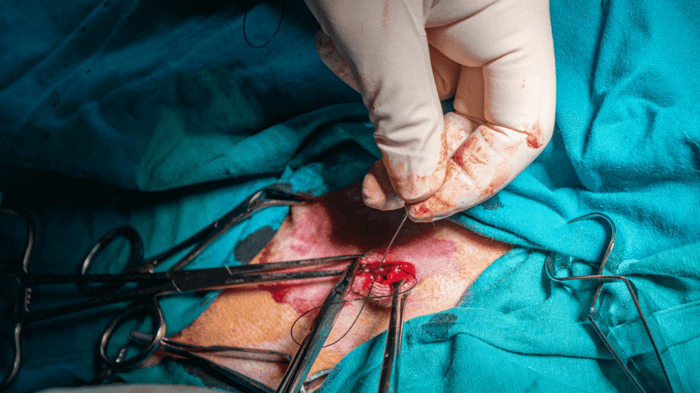
First and foremost, it is essential to contact your veterinarian and let them know what you’ve observed. They may want to see your dog to assess the situation and determine if further treatment is necessary.
In the meantime, there are a few things you can do to help prevent infection and promote healing. These include:
- Keeping the area clean: Use a warm, damp cloth to clean the area around the incision site gently and dry thoroughly. You can also use a bulb syringe to apply warm water to the wound and then dry the site. Be sure to avoid getting any soap or other cleaning agents on the wound itself.
- Applying a clean, dry dressing: If your veterinarian recommends it, you may need to apply a clean, dry dressing to the incision site to help keep it protected and clean.
- Limiting your dog’s activity: Depending on the severity of the situation, your veterinarian may recommend limiting your dog’s activity to help prevent further damage to the incision site.
Overall, it’s essential to take any concerns about your dog’s surgical incision seriously and seek veterinary care as soon as possible. With proper care and attention, most incisions will heal without issue.
Why Would A Dog’s Stitches Open But Not Bleed?
When a dog has undergone surgery, it is common for the veterinarian to use stitches to close the incision. However, sometimes, these stitches may open up, which can be concerning for pet owners for the following reasons:
1. Scab Formation
One reason for non-bleeding open stitches is that the incision may have already formed a scab, which is a natural part of the healing process. The scab can act as a barrier to prevent bleeding, even if the stitches have opened up. In addition, the dog’s body may have already started to produce a blood clot to help stop any bleeding.
2. Shallow Incision
Another reason the stitches may not be bleeding is that the incision is not deep enough to cause significant bleeding. If the incision is near the surface of the skin, it is less likely to cause bleeding.
3. Dissolvable Stitches
Some stitches are designed to dissolve over time. If your veterinarian used dissolvable sutures, they may have naturally dissolved, leaving the incision open.
4. Excessive Activity
Your dog may have engaged in activities that put stress on the surgical site, leading to the opening of the wound. Dogs can sometimes reopen their incisions by scratching, biting, or being overly active.
5. Tension in the Tissues
If the incision site was under tension, such as in areas with a lot of movement or loose skin, the stitches may not hold as well, and the wound may open. This does not always result in bleeding at the site.
6. Infections
Infections or abscesses can weaken the tissue around the incision site, causing it to break open, even if active bleeding doesn’t occur.
It is important to note that even if the stitches are not bleeding, it is vital to seek veterinary care. The open incision can still become infected, leading to severe health problems. The veterinarian may need to clean the wound and apply new stitches or other treatments to help the incision heal properly.
Understanding Dog Stitches
Types of Stitches
There are several types of stitches that a veterinarian may use to close a wound on a dog. Some of the common types of stitches include:
- Interrupted sutures: These are individual stitches that are tied off separately. They are used to close wounds that are not under a lot of tension.
- Continuous sutures: This stitch type creates a single, continuous loop of suture material. It is used for wounds under tension, such as those on the skin.
- Subcuticular sutures: This type of stitch is placed under the skin and is used to close wounds that are deep and not under tension.
- Vertical Mattress sutures: Studies show that vertical mattress sutures distribute tension evenly across the wound, reducing the risk of tissue damage. This is why they’re commonly used in wounds where there’s a lot of pressure.
Stitch type makes a difference in recovery. Studies show that the continuous suture technique resulted in a better cosmetic appearance after wound healing than the interrupted suture technique. Additionally, the continuous pattern eliminates the need for stitch removal.
Purpose of Stitches
The purpose of stitches is to bring the edges of a wound together so that it can heal properly. Stitches also help to prevent infection and promote healing. When a wound is left open, it is more susceptible to infection and may take longer to heal.
If a dog’s stitches are open but not bleeding, it is essential to monitor the wound closely for any signs of infection. The wound should be kept clean and dry as you contact your vet, and the dog should not be licking or scratching the area.
Sometimes, a vet may need to replace the existing stitches with new ones. This may be necessary if the wound is not healing correctly or if there is a risk of infection. It is essential to follow the instructions carefully to ensure the wound heals properly and prevent complications.
Recognizing Open Stitches on A Dog
Although stitches hold the skin together, they can sometimes come open. Recognizing open stitches on a dog is vital to prevent further complications. Visual indicators and behavioral signs can help determine if a dog’s stitches are open.
Visual Indicators
One of the most obvious visual indicators of open stitches is a gap in the skin where the incision was made. The skin may appear to be pulled apart, or the edges of the skin may not meet. In addition, there may be swelling or redness around the incision site. The area may also be warm to the touch or have discharge.
Behavioral Signs
Dogs may exhibit behavioral signs when their stitches are open. They may lick or bite at the incision site, which can cause further damage and delay healing. Dogs may also be more lethargic or have a decreased appetite. In some cases, dogs may even develop a fever.
It is essential to monitor a dog’s behavior after surgery to ensure that the incision is healing properly. If any of the visual indicators or behavioral signs are present, it is vital to contact a veterinarian immediately. Open stitches can lead to infection and delay healing, which can cause further complications.
Immediate Steps to Take For Open Stitches on A Dog
Contact Your Veterinarian
Clean the Wound
Apply a Sterile Dressing
Prevent the Dog from Licking the Wound
Monitor the Dog’s Behavior
Preventing Further Damage To a Dog’s Stitches
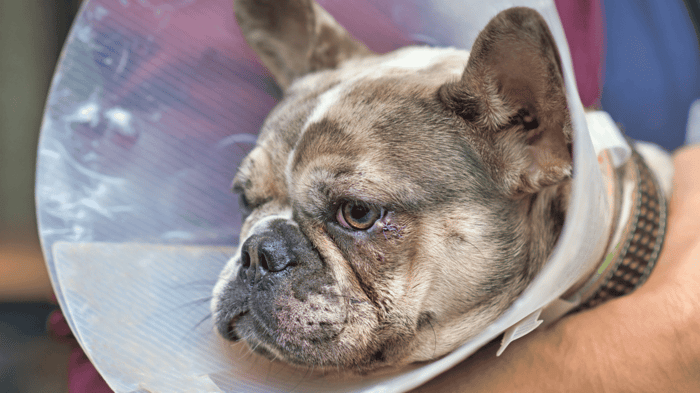
When a dog’s stitches open up but are not bleeding, it is vital to take steps to prevent further damage. Here are some ways to do so:
Limit The Dog’s Activity
First and foremost, it is crucial to limit the dog’s activity. This means keeping them from running, jumping, or engaging in any other high-energy activities that could cause the wound to open up further. Restricting the dog’s movement may also be necessary by confining them to a crate or small room.
Use Protective Gear
Another way to prevent further damage is by using protective gear. This could include a cone or Elizabethan collar to keep the dog from licking or biting at the wound or a bandage or wrap to cover the area and keep it clean. It is vital to ensure the protective gear fits properly and does not cause any discomfort or irritation to the dog.
When to Consult a Vet About A Dog’s Stitches Opening but Not Bleeding
In general, it is best to consult a vet anytime a dog’s stitches open, even if they’re not bleeding. Signs that a dog’s stitches may not be healing correctly include redness, swelling, discharge, and a foul smell.
If a dog’s stitches are open but not bleeding, it may be possible to wait a day or two to see if they begin to heal on their own. However, if the stitches do not appear to be healing or the dog shows signs of discomfort, it is best to consult a vet.
Sometimes, a vet may need to re-stitch the incision to ensure proper healing. Additionally, a vet may prescribe antibiotics to prevent infection or pain medication to help the dog feel more comfortable.
Related post:
Why is my Dog Shaking After Shots?
Long-Term Care and Healing Process
After a dog has undergone surgery to close an open wound, it is essential to provide the right care to ensure proper healing. Here are some tips for long-term care and the healing process:
Keep the wound clean
It is essential to keep the wound clean to prevent infection. The area around the wound should be cleaned with warm water and a mild soap. Avoid using harsh chemicals or disinfectants as they can irritate the wound.
Monitor the wound
Keep an eye on the wound to make sure it is healing properly. If the wound is getting worse or not healing, contact a veterinarian. It is also essential to monitor the dog for signs of infection, such as swelling, redness, or discharge.
Prevent the Dog from Licking the Wound
There’s a lot of emphasis on keeping dogs away from their wounds for proper healing. Dogs may try to lick their wounds, which can interfere with the healing process and lead to infection. Use a cone or other device to prevent the dog from licking the wound.
Provide a healthy diet
A healthy diet can help the dog’s body heal faster. Provide a balanced diet that includes protein, vitamins, and minerals. Avoid giving the dog any treats or human food that could interfere with the healing process.
Follow the Veterinarian’s Instructions
The veterinarian may provide specific instructions for caring for the wound and may prescribe medication to help with the healing. Follow these instructions carefully to ensure the best possible outcome.
By following these tips, dog owners can help their pets heal well after surgery and prevent complications.
Potential Complications
When a dog’s stitches are open but not bleeding, there are still potential complications that can arise. These complications can include:
Infection
When a dog’s stitches are open, there is a risk of infection. If bacteria or other pathogens enter the wound, it can become infected. Signs of infection include redness, swelling, discharge, and a foul odor.
Delayed Healing
If a dog’s stitches are open, it can delay the healing process. The wound may take longer to close and may require additional treatment to heal fully.
Scarring
If a dog’s stitches are open, it can lead to scarring. The wound may not heal properly, and the scar tissue may be more visible or more prominent than it would have been if the wound had been correctly closed.
Reopening of the Wound
If a dog’s stitches are open, there is a risk that the wound may reopen. This can happen if the dog scratches or bites at the wound or is not correctly cared for.
Frequently Asked Questions (FAQs)
How can I tell if my dog’s internal stitches have been ripped?
What are the signs that my dog’s wound has opened after stitches were removed?
What is the recommended time frame for stitches to close on a dog?
Is it common for dogs to pull out their stitches?
Can a dog lick their wound after stitches have been removed?
Final Thoughts
It is vital to keep a close eye on a dog’s stitches after surgery to ensure they are correctly healed. If the stitches appear open but are not bleeding, it is essential to contact the veterinarian immediately. While it may be tempting to treat the issue at home, seeking professional medical advice to avoid any potential complications or infections is crucial.




